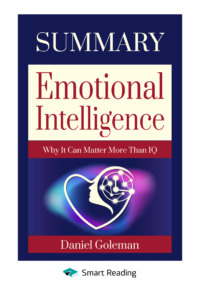Kitobni o'qish: «Summary: Emotional Intelligence. Why it can matter more than IQ. Daniel Goleman»
Автор:
Daniel Goleman
Оригинальное название:
Emotional Intelligence. Why it can matter more than IQ
www.smartreading.ru
Emotional Intelligence and What Depends on It
In the preface to the third edition of his book, Daniel Goleman proudly states that he was the one who popularized the term "emotional intelligence". Prior to the publication of his book, this term was known only to a limited circle of specialists. Today, some 23 years later, the term has become so common that it is often used not only in the media, but also in advertising.
The concept of "intelligence quotient" (IQ) was introduced in the early 20th Century, but it became truly trendy in the 1960s, when it spurned the subsequent widespread use of IQ tests. Finally, people could use a simple and clear tool for assessing intelligence. Following its introduction, the test reduced a person’s entire set of abilities, skills, and potential to one single figure. What was the result? Recruitment soon became the comparison and analysis of numbers. Employers did not shy away from telling potential candidates that they were only interested in the intellectual abilities of future employees, thus making IQ testing a decisive factor in hiring.
However, it soon became clear that the scope of a person’s personality could not be reduced to just one figure. High IQ, as it turned out, was not always the key to success. It soon became clear that a less one-sided way of assessing a person’s potential was needed. Scientists started talking about the role of emotions as a success factor, not only in people’s persona lives but also in their professional lives.
As a result, the term "emotional intelligence" (EI) appeared, which could now address the degree of emotional development of people, their ability to understand their own emotions and the emotions of other people and how they could influence them.
This book is about how psychology has evolved towards an understanding of emotional intelligence. The first part of the book is devoted entirely to a detailed explanation of where in the brain emotions originate and what provokes them, as well as how they affect other brain processes. The author explains to us what emotions are and how important it is to learn to recognize them in yourself and others. In the second part of the book, the author explains how to put emotions to good use and how to manage them. The third part of the book is devoted to emotional development. It explains how a person learns to be capable of emotions and why the right environment for emotional development is so important.
Daniel Goleman’s book was virtually the first source of popular science literature in this area. His book contains significant amounts of scientific evidence available at that time concerning the importance of develop emotional intelligence. Now the book is over 20 years old, but it is still relevant and worth reading in order to gain fundamental knowledge about how emotions affect us and our lives, and what we can do with them.
Anatomy of Emotions
One of the most popular themes in science fiction works often envisages that people will someday become enslaved by artificial intelligence. At first glance, it seems that this is possible: after all, a computer is already "smarter" than a human and can perform highly technical operations in a fraction of a second, a speed that is unattainable to the human brain. However everything is not so clear-cut. Scientists have succeeded in proving that almost all people make all their decisions not on an intellectual, but rather on an emotional level.
Once in the US state of Louisiana, a terrible tragedy occurred: a railway bridge collapsed under a train and the cars, filled with passengers, crashed into the river. The parents of wheelchair-bound 11-year-old Anna Chauncey managed to push their daughter out of the sinking car at the last second, as a result of which she escaped. However, they were not so lucky. This act of parental selflessness needs no explanation from a human point of view, but what is it dictated by, if not emotions? After all, the logical question becomes, is the life of one disabled person more valuable than the life of two able-bodied people.
However, this topic is not only relevant in the personal realm, but also very much so in the professional sphere. An analysis of the neural connections of the brain and the sequences in which they begin to act shows us that any decision has an emotional tint. But very often, especially when it comes to work, we are not aware of the emotional component and believe that we are acting purely rationally.
When we sign a contract with a business partner, we activate the same centers in our brain as if we are choosing a restaurant for our first date.
All our lives, albeit unconsciously, we are guided by emotions. That is why it is so important to study them and understand how to manage them.
For those who are skeptical it will be useful for them to conduct the following experiment: imagine two people, one of whom is completely devoid of emotional intelligence, but at the same time has a very high intelligence quotient (IQ), and a person who has no analytical skills, but who has a feel for others, has a high level of empathy and is able to establish interpersonal relationships. Which of them will succeed in life? The answer is obvious: a human-robot, no matter how highly intelligent it may be, can never become an effective leader or a good partner. But an emotionally gifted person will always be able to establish contact with and organize others, even those who are more intellectually developed, while understanding the feelings of his or her partner.
The amygdaloid body, or amygdala, the area of the brain located in the temporal lobe of the hemisphere, is responsible for the emergence of emotions. Humans have two amygdalae, one in each hemisphere.
Bepul matn qismi tugad.








